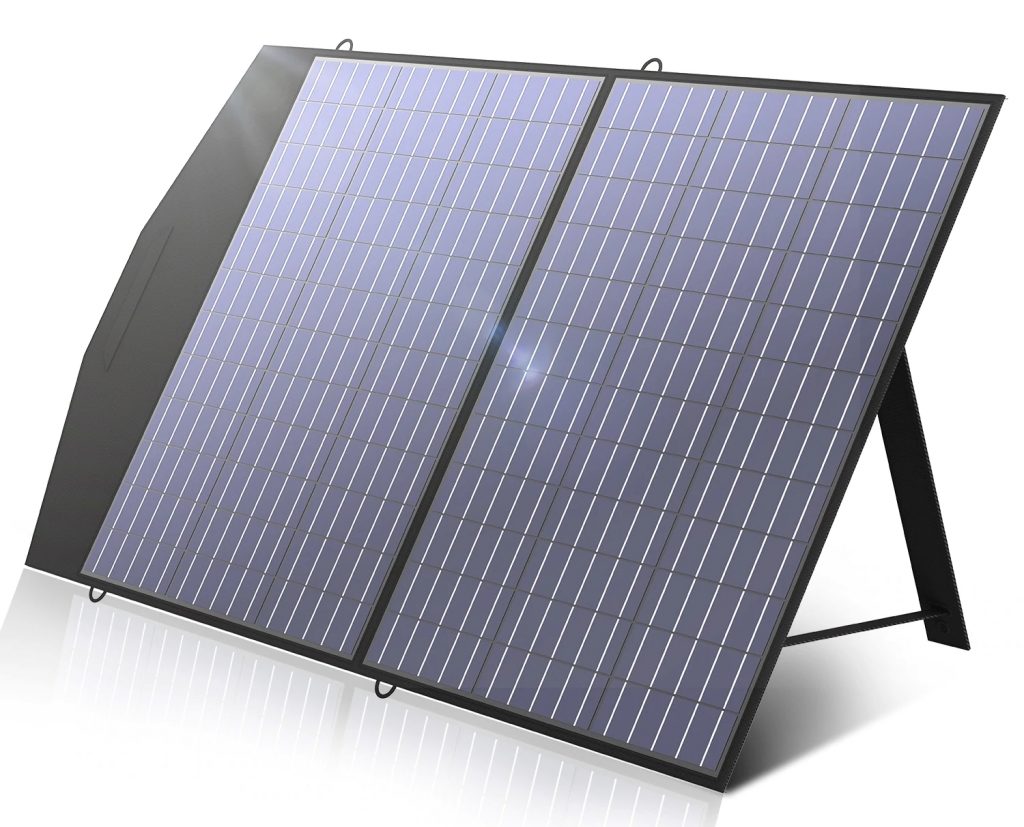If you’re looking for solar panels for your solar generator, this article will undoubtedly come in handy!
Solar generators offer a great energy solution for those who like exploring the outdoors without sacrificing the comfort that only electricity provides.
However, to unlock the full potential of your solar generator, you need to pair it with a good portable solar panel.
Choosing the best solar panels for your solar generator can be exhausting. So, in this article, we’ll answer a few common questions related to solar panels for charging solar generators.
Additionally, we’ll include a complete buyer’s guide with the 7 best solar panels for your solar generator.
Table of Contents
How Are Solar Panels For Solar Generators Different?
Although they work the same way as fixed solar panels, solar panels for solar generators are designed to be fully portable. Most solar panels for solar generators are foldable to facilitate transportation.
Fixed solar panels (the ones you can mount on the roof of your RV, campervan, or house) are heavy and thick due to their many layers (including a glass layer) and aluminum frame.
Conversely, solar panels for solar generators are incredibly lightweight, compact, and portable, so you can easily take them on your camping trips and outdoor activities.

Source: goingsolar.com
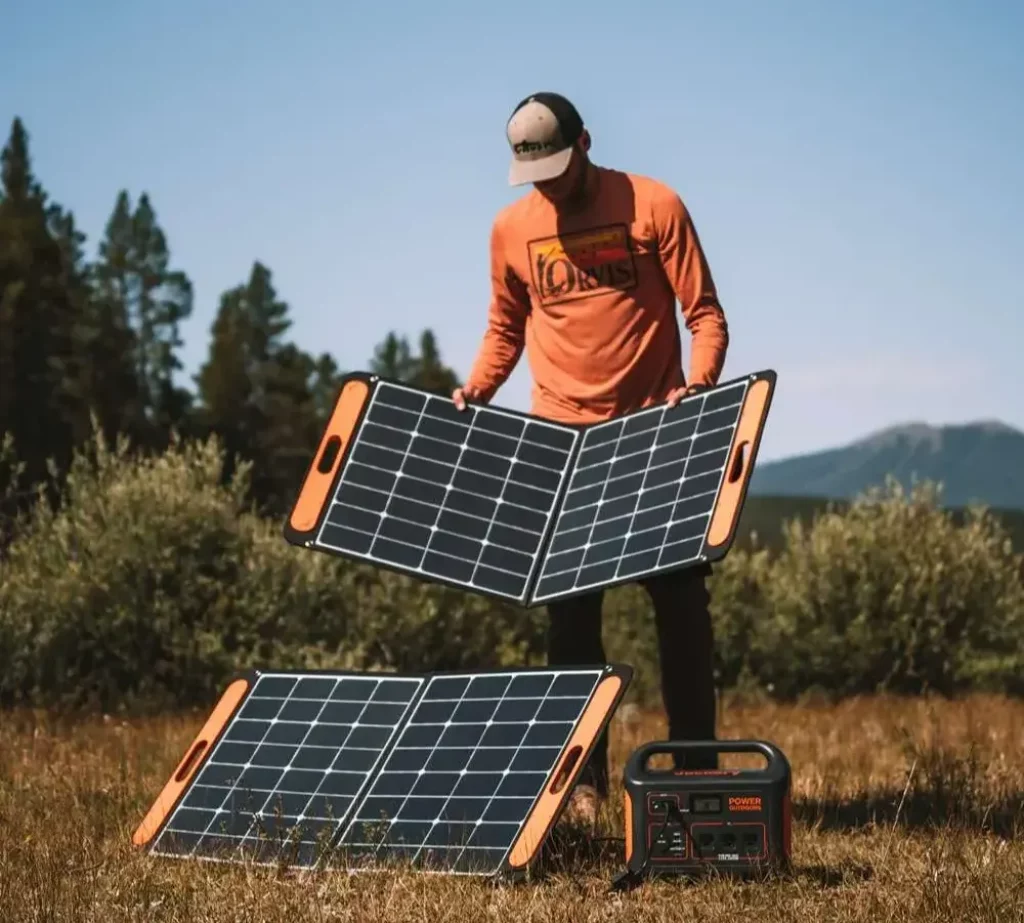
Source: jackery.com
How Can You Connect A Solar Panel To A Solar Generator?
Connecting a solar panel to a solar generator is as straightforward as it sounds. You simply plug your portable solar panel’s output cable into your solar generator’s input port, and it should start charging.
However, when using third-party solar panels to charge your power station, things can get a bit complicated if the output plug from your solar panel is not compatible with the input port on your solar generator.
If that’s your case, don’t worry; we’ll show you a simple way around it shortly.
Common Types Of Solar Panel Connectors
Let’s first look at the types of solar panels output connectors commonly found on portable solar panels:
1. MC4 Connector

Primarily found on rigid solar panels, the MC4 connector is also used as the output plug for some foldable solar panels.
This connector is foolproof. You can’t connect it incorrectly as there’s only one way to do it.
Positive and negative ends are different from one another.
2. Anderson Powerpole Plug

Because newer solar generators usually have an Anderson port as an input option, this type of connector is becoming more frequently found as the type of output of portable solar panels.
It usually allows a current of 30A, making it a good option for charging a solar generator with multiple solar panels in parallel.
3. DC 8mm Plug

Because solar panels produce direct current power, DC outlets are a common input option for small solar generators, as they aren’t recommended for high amperages.
They are pretty simple, as there’s only one cable instead of the two cables on the Anderson Plug (a red one and a black one).
DC plugs come in various sizes, not only 8mm.
Solar Generator’s Input Ports (For Solar Power)
Depending on the brand, solar generators can have different solar input ports. However, they are usually one of the following options:
- Anderson power pole
- DC Input (8mm or other)
- XT60 (usually for EcoFlow power stations)
Some solar generators come with not one but two of these solar input options. An example is the Jackery Explorer 1000, which comes with an Anderson port and a DC port as the solar power input options:

Source: adapted from jackery.com
Solar Panels’ Output Plug Adapters
If you decide to use a third-party solar panel on your solar generator, you need to consider both the type of output plug your solar panel offers and your solar generator’s type of input port.
If they’re compatible, great, you can plug it in, and your solar generator should start charging when you place the solar panel under direct sunlight.
However, if they are not compatible, you’ll need to use the correct adapter.
For example, let’s imagine you have a generic portable solar panel with an MC4 connector as the output plug, and you want to connect this solar panel to your solar generator. However, your solar generator has only a DC port as the solar input, so they’re incompatible:

In this case, to connect the solar panel to the power station, you would need to use an MC4 to DC adapter, like this one:

Other types of useful adapters for similar situations are:
1. MC4 To Anderson Plug Adapter:
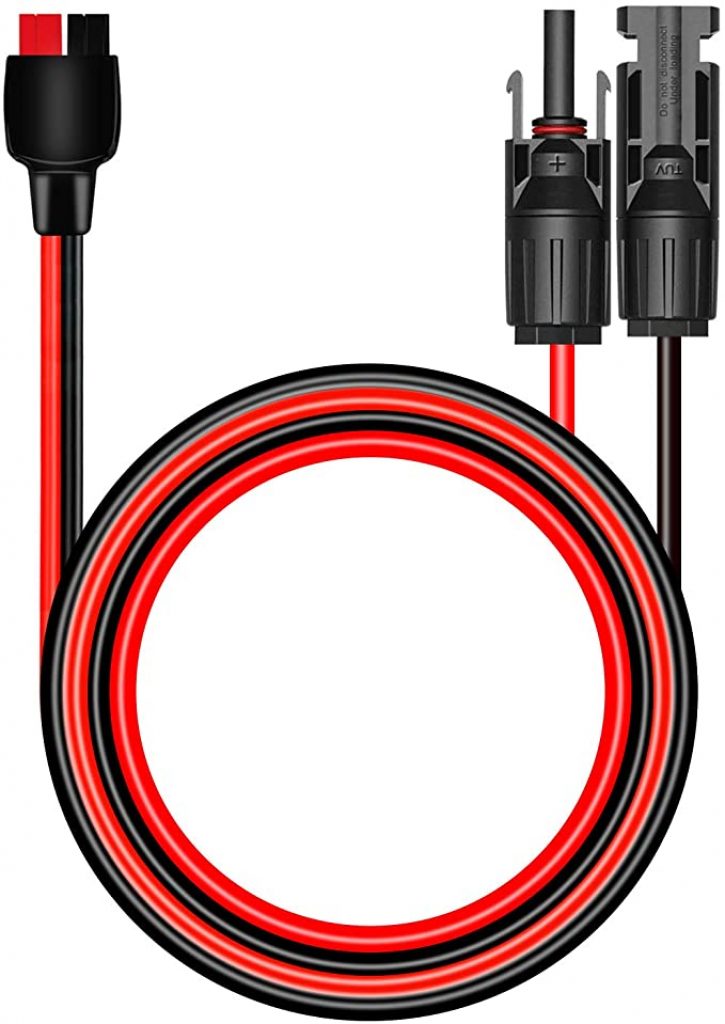
2. MC4 To XT60 Adapter:
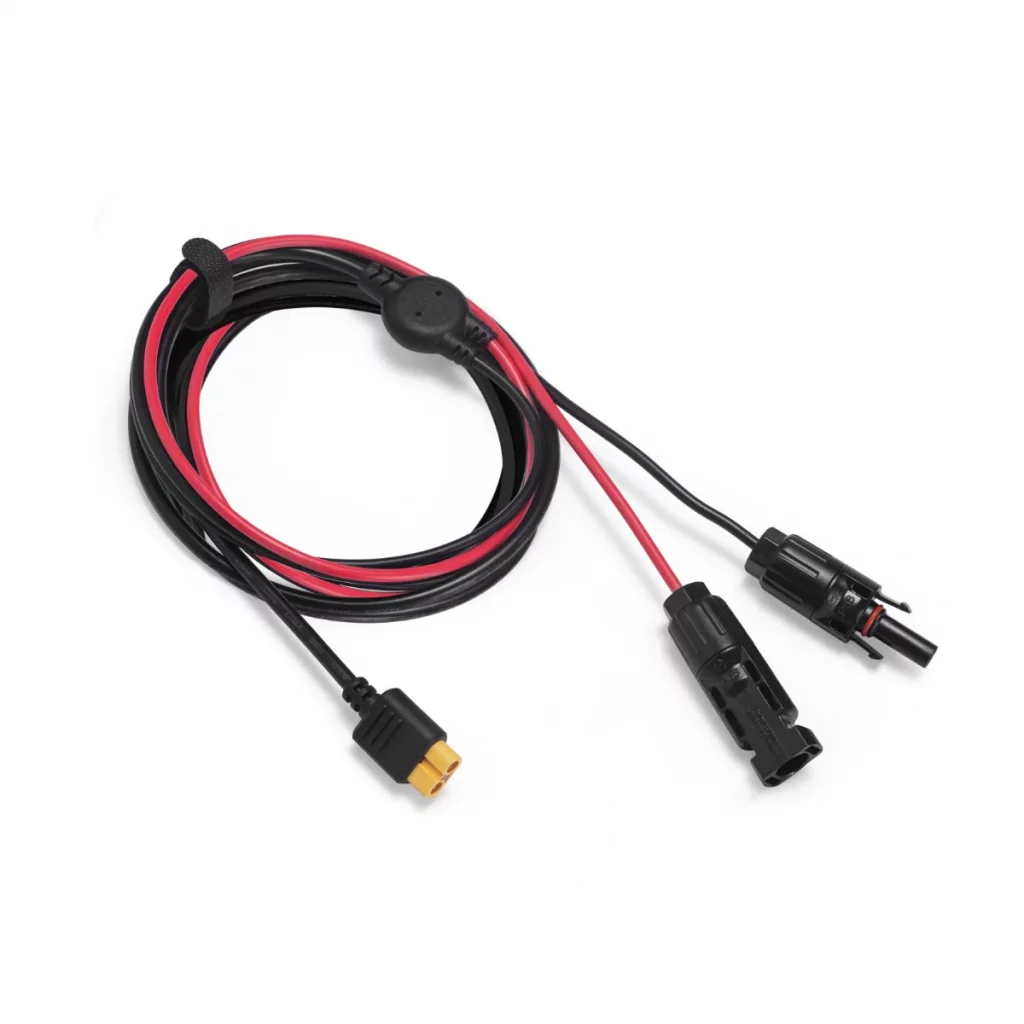
3. Anderson Plug To DC Adapter:

4. Different DC Plugs’ Sizes:

You can easily find these adapters on Amazon. Alternatively, you can make a DIY adapter if you have the skills by buying separate connectors and cables.
You now know how to connect any solar panel to any solar generator with the information provided.
However, plug compatibility isn’t the only factor you should consider when connecting a solar panel to a solar generator.
When choosing solar panels for a solar generator, it’s essential to consider the panel’s voltage, current, and wattage (rated power). The wattage is the amount of power that the panel can generate in full sun. For instance, you can’t charge a solar generator rated with 100W of a maximum solar input with a 200W solar panel.
It’s likely that your solar generator won’t charge, but it probably won’t suffer any damage because most solar generators have protection against overvoltage, overcurrent, and overload.
However, we advise you always to read the User Manuals to check if the solar panel’s output specs and solar generator’s input specs are compatible. This way, you’ll prevent any damage to your equipment and avoid safety risks.
How Many Solar Panels Can You Connect To A Solar Generator?
It depends on the rated solar input of your solar generator and the rated power output of your solar panel.
The total power delivered by your solar panel (or panels) should not exceed the maximum solar input that your solar generator’s built-in charge controller can handle. This “rule” will dictate how many solar panels you can connect to your solar generator.

Source: bluetti.eu
Here are a few examples to make this concept easier to understand.
Example 1:
You have a small solar generator with a rated solar input of 100W max. Therefore, the power delivered by your solar system must not exceed 100W, regardless of how many solar panels you’re using. In this case, it would be recommended to use only one solar panel with 100W of maximum power output.
Example 2:
You have a medium-size solar generator as a backup system for occasional power outages and camping trips. Its rated solar input is 200W max. In this case, you can either connect a 200W solar panel or two 100W solar panels.
However, you should also consider your solar generator’s maximum voltage input and maximum current input to evaluate if connecting multiple panels is a real option or not.
Depending on how you pair the solar panels (in series or parallel), the output voltage or current can exceed the maximum rate for your solar generator. So make sure you do your research when connecting multiple solar panels to your solar generator.
Example 3:
You have an extensive solar generator system, for home backup power, with a total solar input of 2400W.
In this case, you can add as many solar panels as long as the maximum power (2400W), voltage, and current of the system are not exceeded.
Connecting Solar Panels In Series
A series connection is when you wire solar panels together by connecting the positive lead on one solar panel to the negative lead on another solar panel.

Source: adapted from bluettipower.com
When you connect solar panels in series, the total output voltage of this system is the sum of the output voltage of each solar panel. The same goes for the wattage. However, the current is kept constant.
For instance, let’s say you connect three solar panels in series, with each panel rated for 100W of power output and an 18V open circuit. Therefore, this system’s total open circuit voltage will be 18V + 18V + 18V = 54V. The same way, the total output power will be 100W + 100W + 100W = 300W.
You would only be able to connect the solar system from the previous example to a solar generator that could handle the 300W of solar input and 54V of voltage input.
Here’s a simple scheme of how to wire solar panels in series.

Connecting Solar Panels In Parallel
Parallel wiring requires the positive leads of the solar panels to be connected and the negative leads to be connected. A multibranch connector is then used to transform the many solar panel leads (positives and negatives separately) into a single lead that you can plug into the solar generator.
This method increases the current and the wattage output while keeping the voltage constant.
So if you wire two solar panels of 150W, 18V, and 6A (each) in parallel, then the total power output will be 150W + 150W = 300W, the total output current will be 6A + 6A = 12A, and the voltage will be kept constant at 18V.
This is a good wiring option for solar generators that accept a higher wattage but can’t handle high voltages.
Here’s a simple scheme on how to wire solar panels in parallel:
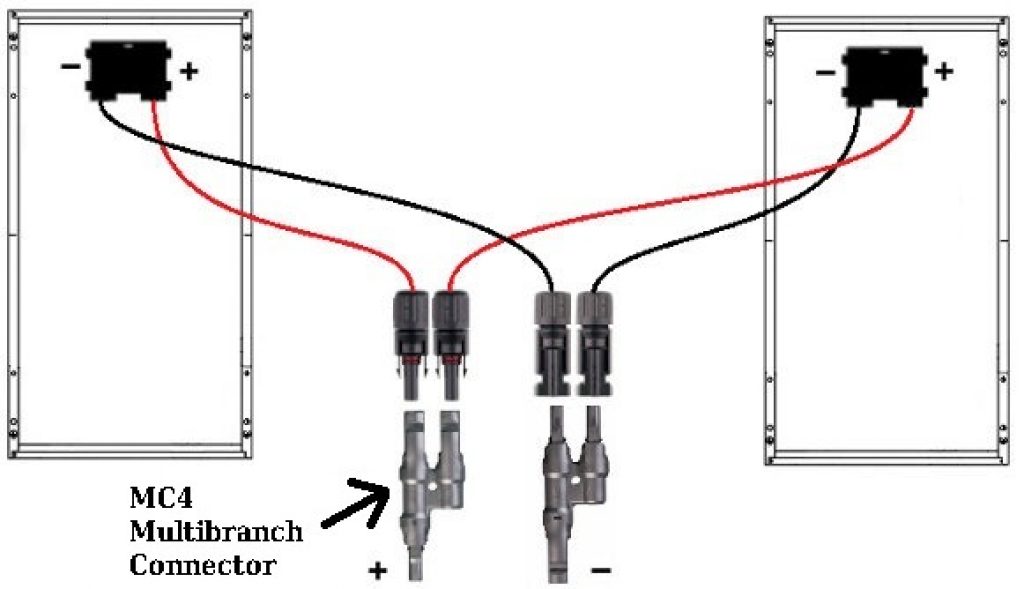
Before connecting solar panels in series or parallel, check the user manual to see if they allow for this connection. Some small solar panels can’t handle being paired with other solar panels.
Furthermore, some solar panels can only be paired with solar panels from the same brand and with the same specs.
For example, BLUETTI recommends only plugging their PV200 solar panels with other PV200s. They explicitly advise against connecting their PV200 to third-party solar panels.
Keep these things in mind, and you shouldn’t have any problems connecting your solar panels.
Can Different Solar Panel Brands Be Used on The Same Solar Generator?
Separately, yes. If your different solar panels are compatible with your solar generator and if you respect your solar generator’s input specs, you should have no problem using other solar panel brands to charge it.
Example: Let’s say you have a solar generator from Jackery and solar panels from AIMTOM and BALDR. After reading the user manual of each one of your devices, you’ve concluded that both solar panels are compatible with your Jackery power station. Therefore, you could plug either (separately) into your Jackery, and it should start charging.
However, pairing solar panels from different brands (whether in series or parallel) is a more delicate matter.
Pairing Solar Panels From Different Brands
As previously mentioned, some solar panel manufacturers strictly advise against pairing solar panels from different brands.
That’s because each brand applies its own technology to its solar panels, so not all solar panels are compatible with each other.
Some are equipped with a microchip that controls input and output, while others are not. This difference in design and technology can result in the malfunctioning of your solar panels (from different brands).
Having said that, in most cases, if you have solar panels from different brands that have the same output specs (wattage, voltage, and amperage) and the manufacturers don’t explicitly advise against pairing them with other solar panel brands, then you shouldn’t have any problems doing so.
In any case, always read your solar panel’s user manual to check if they allow for such operation.
Can I Use My Solar Generator While Solar Panels Are Connected To It?
Yes, most solar generators support pass-through charging.
This feature allows you to charge devices connected to your power station while the power station itself is also being charged.
However, there are a few things you should be aware of:
1. Read The User Manual
Only in the user manual, you’ll find the information you need regarding pass-through charging.
2. Demand Should Not Exceed Supply
Be mindful of the amount of power being drawn for your power station while it’s being charged. If the power you’re drawing from the battery is greater than the power coming into the solar generator, your battery may not charge properly or never reach full charge. This can shorten the battery’s lifespan.
3. Charging Will Take Longer
As you use your solar generator you are depleting its energy. This means it will require more solar power to charge fully.
4. There’s An Increased Risk Of Overheating
While pass-through charging is safe, it can lead to excessive heating of your solar generator. Therefore, be aware of overheating your power station while solar panels are connected to it.
In conclusion, while pass-through charging is possible for most solar generators, it may shorten your battery’s life. Only use this feature if you need it. If you can avoid it, do so.
How Long Do Solar Panels Take To Charge a Solar Generator?
You can roughly estimate how long it would take to fully charge your solar generator using solar panels if you consider the maximum power output of your solar panels and the rated capacity of your solar generator.
With these numbers at hand, you can use the following formula:
Charging Time (hours) = Solar generator’s capacity (Wh) /
Solar panel’s maximum power output (W)
Here are a few examples:
Example 1: Using a 200W solar panel to charge a 500Wh power station
Charging Time (hours) = 500Wh / 200W = 2.5 hours
Example 2: Using a 200W solar panel to charge a 1000Wh power station
Charging Time (hours) = 1000Wh / 200W = 5 hours
Example 3: Using a 200W solar panel to charge a 2000Wh power station
Charging Time (hours) = 2000Wh / 200W = 10 hours
However, this is only an approximation. The rated power of solar panels corresponds to the maximum power it can deliver in ideal conditions.
Therefore, only in ideal conditions (only achieved in the controlled environment of a testing lab) a 200W solar panel will actually deliver 200W of power.
Factors that affect solar power production
In reality, solar panels deliver less than their maximum rated power. In addition, they don’t deliver the same amount of power all the time.
This happens because the ability of solar panels to generate electricity is affected by several different factors, such as:
- The intensity of solar radiation
- Orientation of the solar panel
- Weather
- Cloud coverage/shades
- Temperature
- Atmospheric pollution
- Season
- Time of day
- Location
- Angle in relation to the sun
- Humidity
- Heat buildup
To get a more accurate approximation, you can consider that the actual power delivered by your solar panel corresponds to 80% of its rated power.
This way, if your use a 200W solar panel to charge a 1000Wh solar generator, it would take 6.25 hours to charge fully:
Charging Time (hours) = 1000 Wh / (200W x 0.8) = 6.25 hours
Moreover, you can use a watt meter to measure the actual power output of your solar panel and use this number to calculate how long it would take to charge your solar generator.
Example: Let’s say you’ve measured the actual power output of your 200W solar panel and found out that only 174W is being delivered by it. In this case, to charge a 1000Wh power station, it would take:
Charging Time (hours) = 1000 Wh / 174W = 5.74 hours
Most newer solar generator models will display how much power is being delivered by the solar panels (aka the solar input) and automatically calculate and display how long it will take to charge the power station fully.
7 Best Solar Panels For Solar Generators
Here are our picks for the 7 best solar panels for solar generators (listed in ascending order of rated power):
1. AIMTOM ASP-60 Portable Solar Panel | 60W
Product Overview:
First up is the smallest solar panel in the market – the ASP-60 from AIMTOM.
This extremely lightweight (only 2.9lbs / 1.35 kg) foldable solar panel provides 60W of clean and free power.
Its easy-to-carry design makes it the ideal solar panel for camping, trekking, or backpacking.
AIMTOM provides several adapters with this product: DC-to-DC, DC-to-MC4; DC-to-SAE and SAE-to-Clamp cable; 10-in-1 connector kit for charging laptops.
You can use it to charge your solar generator as it’s compatible with almost every power station (as long as you use the correct adapter).
Additionally, you can use it to charge your portable devices on the go by plugging them straight into the solar panel’s output options, which offer a USB and a DC port that you can use simultaneously.
Tech Specs:
| Peak power output | 60W |
|---|---|
| Solar Cell Efficiency | Up to 22.2% |
| Solar Connector Type | DC |
| Solar Cell Lamination | PET |
| Extra output options | USB and DC |
| Kickstand | No |
| Dimensions Folded | 11.4 x 6.3 x 2.4 inch or 29 x 16 x 6 cm |
| Dimensions Unfolded | 64.9 x 11.4 x 0.7 inch or 165 x 29 x 1.8 cm |
| Weight | 1.35 kg (2.98 lbs) |
| Price | $139.99 |
2. ROCKPALS RP082 Portable Solar Panel | 100W
Product Overview:
This 100W solar panel from ROCKPALS is compatible with most solar generators on the market. It offers 3 different size connectors: 8 mm DC, 5.5 x 2,1 mm DC, and Anderson plug.
The RP082 weighs only 4.3 kg (9.48 lbs), so it’s ideal for outdoor activities such as camping, climbing, hiking, fishing, or a picnic.
It offers 2 USB ports to charge your small devices directly from sunlight.
This version is upgraded with ETFE Cell Lamination, which maximizes light capture. In addition, ETFE solar panels are far more resistant. They’re waterproof and dust-proof, lightweight, and have a long service life.
Finally, this safe and reliable model has kickstands, so you can adjust the angle in relation to the sun to optimize conditions (90º angle to the sunlight).
Tech Specs:
| Peak power output | 100W |
|---|---|
| Solar Cell Efficiency | Up to 23.5% |
| Solar Connector Type | MC4 |
| Solar Cell Lamination | ETFE |
| Extra output options | 1 x 18W USB-C and 1 x 24W USB QC 3.0 output |
| Kickstand | Yes |
| Dimensions Folded | 16.5 x 15.1 x 1.7 inch |
| Dimensions Unfolded | 71.2 x 16.5 x 0.9 inch |
| Weight | 4.3 kg (9.48 lbs) |
| Price | $229.99 |
3. ALLPOWERS Solar Panel | 100W
Product Overview:
ALLPOWERS offers rugged, reliable, and easy-to-use solar panels to provide you with solar power wherever you are.
This particular solar panel from ALLPOWERS is rated for 100W and is compatible with most solar generators/portable power stations on the market.
It includes different adapters: MC4 to DC 5.5 x 2.1 mm cable and MC4 to Anderson cable. This way, you can easily plug it into a wide range of solar generators.
This foldable solar panel is designed with durable and waterproof nylon and an adjustable bracket to receive the most effective sunlight.
Like all solar panels on this list, the ALLPOWERS 100W can be folded to a “briefcase shape” for easy transport, making it great for any outdoor activity.
Tech Specs:
| Peak power output | 100W |
|---|---|
| Solar Cell Efficiency | Up to 21% |
| Solar Connector Type | MC4 Connector |
| Solar Cell Lamination | ETFE |
| Extra output options | No |
| Kickstand | Yes |
| Dimensions Folded | 51 x 65 × 3 cm or 20 × 25.6 × 1.2 inch |
| Dimensions Unfolded | 122 x 65 × 1 cm or 48 × 25.6 × 0.4 inch |
| Weight | 3.6 kg (7.9 lbs) |
| Price | $159.90 |
4. Togo TSP-120FM Power Portable Solar Panel | 100W
Product Overview:
Togo offers portable power stations and portable solar panels, like the TSP-120FM, that deliver 100W of solar power.
This model is highly versatile — you can use it while RVing, camping, traveling, or preparing your home against power outages.
This solar panel is compatible with most solar generators; you just need to use the correct adapters according to the solar generator’s power input port.
It’s built with Anderson plug, but Togo provides Anderson to DC and Anderson to MC4 adapters.
This unit also features a built-in MPPT control, further increasing your solar panel’s efficiency.
You can use the Togo 100W to charge multiple small devices simultaneously, such as phones, power banks, tablets, laptops, cameras, etc. A smart chip in each unit will adjust the current to match your device’s charging specs.
Tech Specs:
| Peak power output | 100W |
|---|---|
| Solar Cell Efficiency | Up to 23% |
| Solar Connector Type | Anderson plug |
| Solar Cell Lamination | ETFE |
| Extra output options | USB-C, USB-A, and 18V DC |
| Kickstand | Yes |
| Dimensions Folded | 21.2 x 23.8 x 1.6 inch |
| Dimensions Unfolded | 47.7 x 21.3 x 1 inch |
| Weight | 3.8 kg (8.4 lbs) |
| Price | $249.99 |
5. BALDR Portable Solar Panel | 120W
Product Overview:
This 120W from BALDR is designed for compatibility with most solar generators. It comes with different adapters like the DC to XT60 adapter.
Additionally, it provides two USB ports to charge your portable devices directly from the solar panel.
It’s suitable for any kind of weather, and it’s also water-resistant.
This unit offers charging protections like overvoltage, overcurrent, overload, and short circuit protection, preventing any damage to the solar panel or the device being charged by it.
According to the user manual, you can chain other solar panels with the same nominal output voltage power in parallel. However, be aware that the superimposed current must not exceed the current that the connecting cables and plugs can take.
Tech Specs:
| Peak power output | 120W |
|---|---|
| Solar Cell Efficiency | Up to 23.5% |
| Solar Connector Type | DC (comes with adapters) |
| Solar Cell Lamination | ETFE |
| Extra output options | USB-A and USB-C |
| Kickstand | Yes |
| Dimensions Folded | 20.47 x 14.57 x 2.17 inches |
| Dimensions Unfolded | 65.35 x 20.47 x 0.98 inches |
| Weight | 4.5 kg (10 lbs) |
| Price | $219.99 |
6. EcoFlow Foldable Solar Panel | 160W
Product Overview:
EcoFlow is one of the biggest brands in the market of solar generators, so it’s no surprise that it would offer an excellent portable solar panel.
This EcoFlow solar panel delivers 160W of green power on the go. It comes with 32 premium monocrystalline silicon cells, with a conversion efficiency of 22%.
You can chain multiple panels in series or parallel to provide efficient and fast charging to solar generators for house backup power.
Besides being compact, foldable, and lightweight, the EcoFlow 160W is designed to produce maximum power at any time of the day.
Moreover, the case doubles as a stand, providing you with the best angle for solar charging.
Built to withstand an adventurous lifestyle, this panel is entirely dust and waterproof. You can submerge it up to a meter for 30 minutes without damaging it, and its ETFE film provides extra protection against UV rays, prolonging its lifespan.
These solar panels pair with EcoFlow portable power stations and third-party solar-powered generators. Just make sure you have the proper adapter cable.
Tech Specs:
| Peak power output | 160W |
|---|---|
| Solar Cell Efficiency | Up to 21%-22% |
| Solar Connector Type | MC4 Connector |
| Solar Cell Lamination | ETFE |
| Extra output options | No |
| Kickstand | Yes, the case works as a stand |
| Dimensions Folded | 26.8 x 16.5 x 1.0 inch or 68 x 42 x 2.4 cm |
| Dimensions Unfolded | 26.8 x 61.8 x 1.0 inch or 68 x 157 x 2.4 cm |
| Weight | 7 kg (15.4lbs) |
| Price | $349 |
7. BLUETTI PV200 Foldable Solar Panel | 200W
Product Overview:
Last but not least is the BLUETTI PV200 Solar Panel, with 200W of green, eco-friendly power.
Although this product is more expensive than its counterparts, good reviews indicate that it’s well worth the price,
Built with long-lasting ETFE material, it’s more durable, scratch-resistant, and waterproof.
A solar panel this powerful is not only ideal for outdoor activities such as camping, fishing, and hiking but also for charging powerful solar generators, like the ones used as home backup power.
You can also use this solar panel with third-party solar generators like Baldr/Jackery/Goal Zero/Rockpals/AIMTOM.
Tech Specs:
| Peak power output | 200W |
|---|---|
| Solar Cell Efficiency | Up to 23.4% |
| Solar Connector | MC4 Connector |
| Solar Cell Lamination | ETFE |
| Extra output options | No |
| Kickstand | Yes |
| Dimensions Folded | 59 x 63 cm or 23.2 x 24.8 inch |
| Dimensions Unfolded | 59 x 226 cm or 23.2 x 89.2 inch |
| Weight | 7.3 kg (16.1 lbs) |
| Price | $469 |
Final Thoughts
Solar generators are an excellent option for those looking to have access to clean and free energy on the go. Just plug a solar panel into it, and voila, you’ll start producing your energy.
However, choosing the right solar panels for your solar generator can be confusing. There are many different solar panels available, and not all of them will be compatible with your solar generator.
Therefore, when choosing solar panels for your solar generator, you should keep a few things in mind, like the solar panel’s output specs and the solar generator’s input specs.
Moreover, it’s essential to consider the size and weight of the panels. Larger panels will generate more power, but they will also take up more space. Smaller panels are more portable, but they will not generate as much power.
The best choice is to get a solar panel that will maximize the solar input of your solar generator without exceeding its wattage limit. You’ll ensure fast and efficient charging without damaging your solar generator or shortening its battery’s life.




